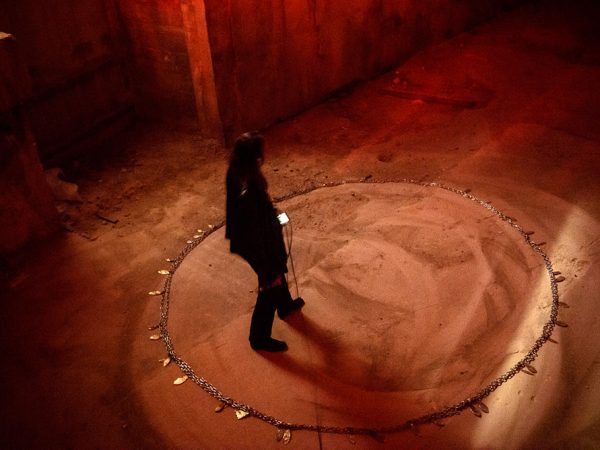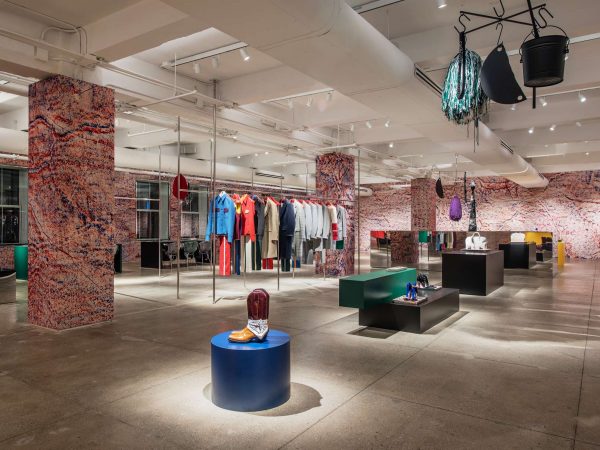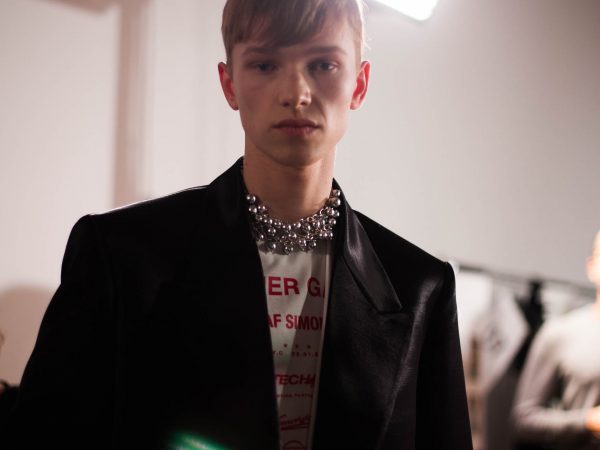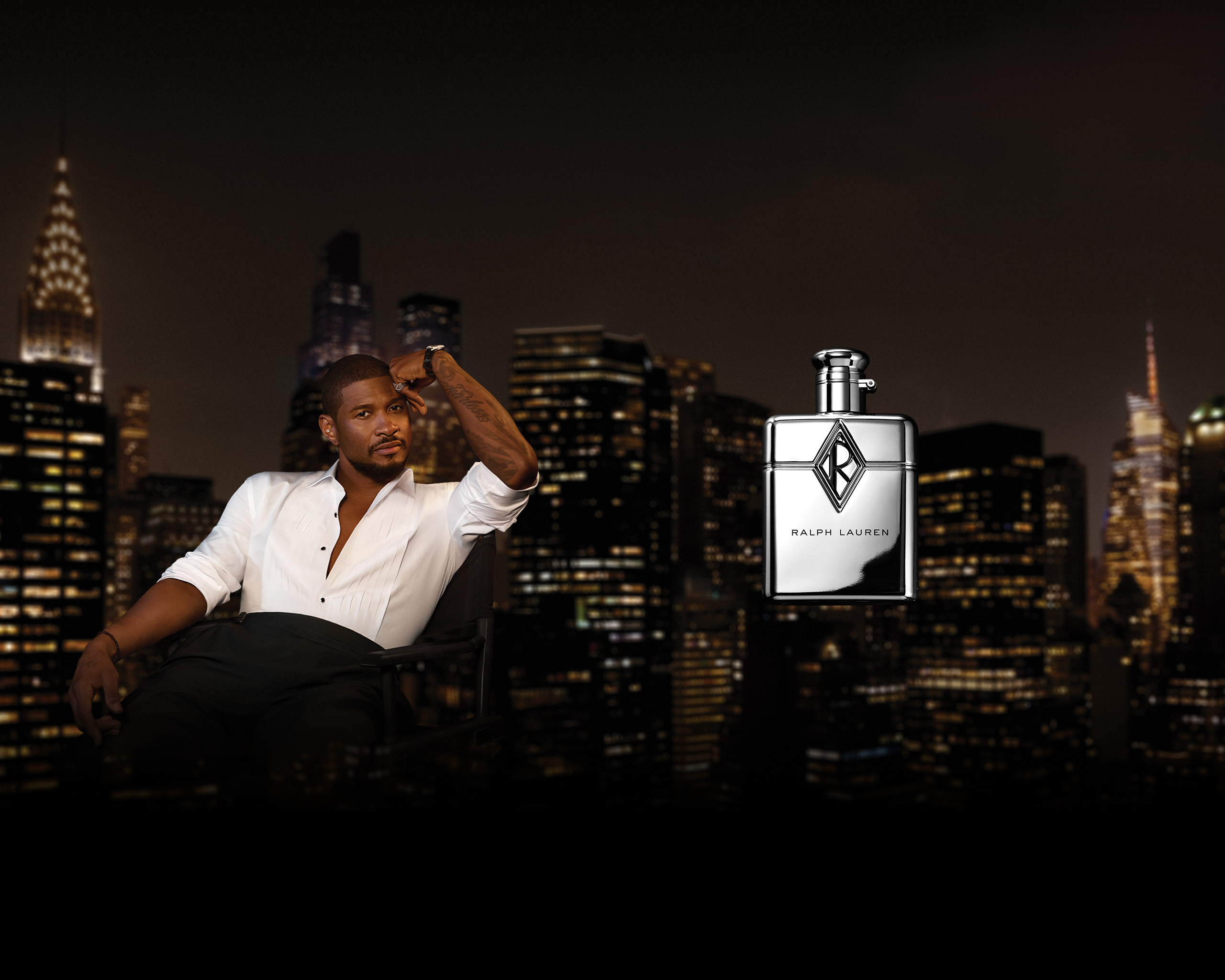“The favorite audiences of a lot of the big new wave bands were the Flemish ones,” says Olivier Rizzo. “You see, for the Flemish audience there was such a level of sick obsession—they could be brainwashed to such an extent by total, heartfelt emotion.”
Obsessive, compulsive, heartfelt, emotional, sick, and worshipful at the altar of pop—each of these things could also be said about Olivier Rizzo himself, as well as the wider Flemish audience idolizing bands like The Smiths, New Order, or Depeche Mode alongside him.
To reduce Olivier Rizzo down to the title of “stylist” is an underestimation; he is more like the member of a quasi-religious cult, the keeper of a pop culture flame, determined to propagate heartfelt emotion through the visual culture of fashion. And in this he has succeeded, perhaps more so than any other stylist working at this point in time—nobody else is quite as obsessive, you see. Add to this that he is chic, tasteful, clever, purposefully stupid, trashy, and a total perfectionist—yet seemingly effortlessly bringing all of these different, disparate strands together—his influence on fashion cannot be underestimated.
I am attracted to how something utterly ugly can be utterly beautiful, and how something fake can be better than something natural.
This is a man that can cry at jackets—it was a Margiela one a few years ago; I witnessed it and have never let him forget it—somebody that can also talk about the emotional significance of Nick Kamen’s “Each Time You Break My Heart,” both the single and the video, in Wagnerian terms of import. And yet this is someone who does not take himself entirely seriously—I mean, how could he? Because ultimately there is something very human about Olivier Rizzo and his desire to communicate with the outside world his interior obsessions. Rather democratically, he wants everyone else to be obsessed by them too. Here Rizzo discusses a few.
Above The Fold

Sam Contis Studies Male Seclusion

Slava Mogutin: “I Transgress, Therefore I Am”

The Present Past: Backstage New York Fashion Week Men’s Spring/Summer 2018

Pierre Bergé Has Died At 86

Falls the Shadow: Maria Grazia Chiuri Designs for Works & Process

An Olfactory Memory Inspires Jason Wu’s First Fragrance

Brave New Wonders: A Preview of the Inaugural Edition of “Close”

Georgia Hilmer’s Fashion Month, Part One

Modelogue: Georgia Hilmer’s Fashion Month, Part Two

Surf League by Thom Browne

Nick Hornby: Grand Narratives and Little Anecdotes

The New Helmut

Designer Turned Artist Jean-Charles de Castelbajac is the Pope of Pop

Splendid Reverie: Backstage Paris Haute Couture Fall/Winter 2017

Tom Burr Cultivates Space at Marcel Breuer’s Pirelli Tire Building

Ludovic de Saint Sernin Debuts Eponymous Collection in Paris

Peaceful Sedition: Backstage Paris Fashion Week Men’s Spring/Summer 2018

Ephemeral Relief: Backstage Milan Fashion Week Men’s Spring/Summer 2018

Olivier Saillard Challenges the Concept of a Museum

“Not Yours”: A New Film by Document and Diane Russo

Introducing: Kozaburo, 2017 LVMH Prize Finalist

Introducing: Marine Serre, 2017 LVMH Prize Finalist

Conscious Skin

Escapism Revived: Backstage London Fashion Week Men’s Spring/Summer 2018

Introducing: Cecilie Bahnsen, 2017 LVMH Prize Finalist

Introducing: Ambush, 2017 LVMH Prize Finalist

New Artifacts

Introducing: Nabil Nayal, 2017 LVMH Prize Finalist

Bringing the House Down

Introducing: Molly Goddard, 2017 LVMH Prize Finalist

Introducing: Atlein, 2017 LVMH Prize Finalist

Introducing: Jahnkoy, 2017 LVMH Prize Finalist

LVMH’s Final Eight

Escaping Reality: A Tour Through the 57th Venice Biennale with Patrik Ervell

Adorned and Subverted: Backstage MB Fashion Week Tbilisi Autumn/Winter 2017

The Geometry of Sound

Klaus Biesenbach Uncovers Papo Colo’s Artistic Legacy in Puerto Rico’s Rainforest

Westward Bound: Backstage Dior Resort 2018

Artist Francesco Vezzoli Uncovers the Radical Images of Lisetta Carmi with MoMA’s Roxana Marcoci

A Weekend in Berlin

Centered Rhyme by Elaine Lustig Cohen and Hermès

How to Proceed: “fashion after Fashion”

Robin Broadbent’s Inanimate Portraits

“Speak Easy”

Revelations of Truth

Re-Realizing the American Dream

Tomihiro Kono’s Hair Sculpting Process

The Art of Craft in the 21st Century

Strength and Rebellion: Backstage Seoul Fashion Week Autumn/Winter 2017

Decorative Growth

The Faces of London

Document Turns Five

Synthesized Chaos: “Scholomance” by Nico Vascellari

A Whole New World for Janette Beckman

New Ceremony: Backstage Paris Fashion Week Autumn/Winter 2017

New Perspectives on an American Classic

Realized Attraction: Backstage Milan Fashion Week Autumn/Winter 2017

Dematerialization: “Escape Attempts” at Shulamit Nazarian

“XOXO” by Jesse Mockrin

Brilliant Light: Backstage London Fashion Week Autumn/Winter 2017

The Form Challenged: Backstage New York Fashion Week Autumn/Winter 2017

Art for Tomorrow: Istanbul’74 Crafts Postcards for Project Lift

Inspiration & Progress

Paskal’s Theory of Design

On the Road

In Taiwan, American Designer Daniel DuGoff Finds Revelation

The Kit To Fixing Fashion

The Game Has Changed: Backstage New York Fashion Week Men’s Autumn/Winter 2017

Class is in Session: Andres Serrano at The School

Forma Originale: Burberry Previews February 2017

“Theoria”

Wearing Wanderlust: Waris Ahluwalia x The Kooples

Approaching Splendor: Backstage Paris Haute Couture Spring/Summer 2017

In Florence, History Returns Onstage

An Island Aesthetic: Loewe Travels to Ibiza

Wilfried Lantoine Takes His Collection to the Dancefloor

A Return To Form: Backstage New York Fashion Week Spring/Summer 2018

20 Years of Jeremy Scott

Offline in Cuba

Distortion of the Everyday at Faustine Steinmetz

Archetypes Redefined: Backstage London Fashion Week Spring/Summer 2018

Spring/Summer 2018 Through the Lens of Designer Erdem Moralıoğlu

A Week of Icons: Backstage Milan Fashion Week Spring/Summer 2018

Toasting the New Edition of Document

Embodying Rick Owens

Prada Channels the Wonder Women Illustrators of the 1940s

Andre Walker’s Collection 30 Years in the Making

Fallen From Grace, An Exclusive Look at Item Idem’s “NUII”

Breaking the System: Backstage Paris Fashion Week Men’s Autumn/Winter 2017

A Modern Manufactory at Mykita Studio

A Wanted Gleam: Backstage Milan Fashion Week Men’s Autumn/Winter 2017

Fashion’s Next, Cottweiler and Gabriela Hearst Take International Woolmark Prize

Beauty in Disorder: Backstage London Fashion Week Men’s Autumn/Winter 2017

“Dior by Mats Gustafson”

Prada’s Power

George Michael’s Epochal Supermodel Lip Sync

The Search for the Spirit of Miss General Idea

A Trace of the Real

Wear and Sniff

Underwater, Doug Aitken Returns to the Real
Mickey Mouse
I think the whole story with Mickey Mouse starts with me as a toddler—like every kid, really. This beautiful, incredible, friendly, but annoying mouse in three colors—black/white, red, and yellow—for me is the perfect, graphic, aesthetic embodiment of so much that I like. Of course I must have fallen in love with him graphically, but I was also attracted to Mickey Mouse as the leader of Walt Disney’s world. For me Mickey Mouse grew to be this symbol that my generation was looking for—this icon of pop that represents a moment in time you can relate to and opens up all sorts of possibilities.
He’s this funny, annoying little character where everything is ultimately about the love of his life: Minnie. Then there is the closeness he has to his friends, like Donald and Pluto. I can relate to all of that—although I have Willy Vanderperre, Raf Simons, and Peter De Potter. He transcends every age in his pop simplicity, but I also think he is a dark, poetic character. This is highlighted in Fantasia when he becomes the sorcerer’s apprentice—you get an insight into his dark side. And his physical features can, at times, look like a skull—he is the single icon with the most interpretations, I think, from the very up to the very down; he’s a Warholian figure.
One of my other obsessions is America and why the iconography of America can mean so much to a European kid. It’s mainly through the eyes of the 80s and how the world looked at America then—the shine of the happy land where all is possible had started to tarnish. Mickey Mouse represents to me the superficial layer of Americana that I love. He is a dream, a number-one icon. When I am in an American city, seeing somebody wearing a Mickey Mouse t-shirt always gets my attention. I started to collect these t-shirts—particularly the grey promotional ones—as a teenager. I picked them out as I was rummaging in flea markets. They also became part of the Paninaro [a preppy youth scene in 80s Milan named for the panino cafés they’d frequent] moment I had—another obsession of mine. There was this amazing brand called Donaldson, which had the logo of Mickey Mouse and featured the whole cartoon world around him. There was a whole moment when Donaldson became huge and but fell out of favor fast. But I continued to like the idea of Mickey Mouse t-shirts. When I got to Antwerp in the early 90s, there was a whole moment of anti-fashion, yet I still stuck with Mickey Mouse—he added a light note. The one Mickey Mouse t-shirt I wore the most through that Grunge period is a 50s one. It looks identical to one worn in The Outsiders, so I was very proud of that.
Mickey Mouse represents freedom, open-mindedness, happiness, and joy; he’s a simple expression of humor and a postwar solution to depression. But ultimately, for me, Mickey Mouse is the one symbol of the Walt Disney world that stands for the opening of your mind and the creation of a total fantasy world. And that’s the thing that makes me most happy: to create fantasy that reaches out to people and really speaks to them.
The Synthesizer
Possibly my core, main obsession is the synthesizer—any synthesiser sound drives me utterly insane. There is no more beautiful sound for me, apart from the sound of nature and the sound of the people I love. The synthesizer transports me; it impacts how I work and how I feel. Part of it is a very generational thing, and I have been receptive to sounds from a very early age—they are really what my memories and nostalgia are made of. I find it very hard to be negative about music featuring synthesizers, from the master of masters, Giorgio Moroder, to the cheap German commercialism of Frank Farian’s “Boney M.” I love, love, love, love it.
Once the synthesizer sound hit the chic, cold, distant generation of the second half of the 70s—I am thinking particularly of Bowie and Eno and the collaboration with Moroder—then it became the perfect pop of the early 80s. My favorite song and perfect pop song is Visage’s “Fade To Grey.” The synthesizer travels through so many things I like and so many influences on me, but what I keep out of it all are the beautiful associations. Synthesizers=new wave=slick design=a neon-lit world…. There is something almost at the edge of kitsch about it all. At the same time there is something very Flemish with new beat and something very English, particularly with Depeche Mode, New Order, and the Human League. Dare by the Human League—is there actually any better album ever, ever? Every intro to each song, it’s some of the finest art of the last century. As for Moroder and Donna Summer’s “I Feel Love,” that is major, major art—some of the greatest art created during humanity’s existence.
The introduction of synthetic music brings together the natural and the unnatural, and this is something that has always fascinated me. My earliest fashion memory is of my kindergarten teacher when I was three years old. She was very pretty, wore an a-line suede-patched skirt and had blue legs. When my mother came to school to pick me up, I asked why my teacher had blue legs—she had bright blue nylon stockings on, of course. After that I kept drawing girls with long blue legs—I was obsessed by this idea of the coming together of something unnatural in something very natural. That quality is what synthesizers have too.
The natural and the unnatural coming together is what makes music so important in a fashion show as well; it’s those nine or ten minutes that music has to grab you and transport you quickly. Every detail of the show experience has to be perfect, but in the audio experience you suggest the world. If conceptually it is decided to make a show visual with no audio, then great, but if you create it fully then every level of detail has to be looked at. You have to create it with the right sound, with the right sound experience. That soundscape should infiltrate your body and become a physical experience. For me there is no way the audio can be disconnected from the visual anyway—in my life it does not exist. Very often the image is created by the sound. And synthesizers stand for a lot in my brain, both in an audio and visual way.
Alchemy
I am attracted to how something utterly ugly can be utterly beautiful, and how something fake can be better than something natural. I think this is a form of alchemy.
It had been my dream to walk into the Royal Academy of Fine Arts in Antwerp since I was 12 or 13 years old—I knew absolutely I wanted to study there. I knew about the first wave of Belgian designers—the Antwerp Six—from the media, and it became this weird, obsessive dream of mine to go to the Academy. In many ways everything started for me by walking through the doors there; things were transformed.
A Flemish painter, one of my favorites, David Teniers II, created the Academy in 1663. The darkness of the building and the weight of history is immense there. My anticipation had been so huge before I went. David Teniers II had also painted a picture I have always been obsessed by, The Alchemist. To me it says it all: the meaning of that word, construction, deconstruction, knowledge, culture, and what taste could be—how you could create something new out of something discarded, how you could make that into something precious.
For me, Flemish painting is indivisible from the Spanish Inquisition; you cannot escape this dark past with the hunting by the inquisitors across the flatlands. In Flemish painting there is also the Baroque and the link to the filmmakers I love from the 80s, like Derek Jarman and Peter Greenaway. There is also frequently a “photographic” approach and a huge influence on much of the photography I like—and in many ways photography is the ultimate form of alchemy for me. Alchemy is also the moment I met Willy [Vanderperre]—my life and my relationship with him means everything.
Everything can be pinpointed in one still image—all of your senses can be put together in one image. The art of photography and that discovery changed everything for me. To get sucked into the photograph, that emotion, the way a photograph communicates—the way it tells me what it wants to tell me—there is nothing else like it. This is where the ultimate transformations take place. And like Flemish painting, with all of its technical advances, there is a will to own the unknown in a photograph.
Skateboarding
I always go back to something related to the skate world, to the known and the unknown qualities that are related to it. Of course, there is a physical expression to it; it’s a sport and an art form, but there is also something more emotionally indefinable that is attached to that world.
For me, being a kid in the 70s, skateboarding was a fun way of playing around in the neighborhood. It was that moment in time—I did not quite realize the bigger impact of it then. I always go back to the shape and forms and the physical extremes of skating, but there is also a mindset that is attached to that; it puts people who practice it in a certain mood of freedom. That mindset makes people belong together, it’s very beautiful and emotional.
Skating has such an impact for me because it takes place within a very urban landscape, and I like the way it is so restrictive physically. I can watch skate kids for hours; I find what they do so soothing. Growing up in the 80s, with the Powell-Peralta world of films, skating became a very beautiful and a very true story: this huge industry built on the talent of a handful of kids. And still it is an industry that feels very true to itself. Whatever skate store you walk into throughout the world, you feel a lot of boundaries disappear. People are kind and nice, and pyramids of hierarchy vanish; people in the skate world all have one goal: to challenge physical ability and gravity. I love that.
Even though you can pinpoint the explosion of skating to certain decades, for me it remains eternally contemporary. And the way of thinking attached to it—an openness, something carefree and
genuine—gives people an incredible way of being. The models who are skaters approach modeling with a completely different attitude; it often makes them great models, really open, unafraid to be themselves and special.
Everything can be pinpointed in one still image—all of your senses can be put together in one image. The art of photography and that discovery changed everything for me. To get sucked into the photograph, that emotion, the way a photograph communicates—the way it tells me what it wants to tell me—there is nothing else like it.
The Fashion Show
The fashion show is the ultimate creation of a live fantasy in front of you. At its best it is a moment of beauty and emotion and delirium that transports you totally. To work on a show physically, creatively, and emotionally, the challenge to achieve this moment perfectly means everything. Fashion is now there to express so much, not just to protect from heat or cold. Even if you choose not to express through fashion, that is still expressing! And the start of all of that is the fashion show.
I am so obsessive as a person and in what I do. I think a lot of this is to do with the creation of an explosion of fantasy in my own mind and in other people’s. The first shows that I saw transported me in such a way. There was screaming, crying, and a pushing of my physical being. These were shows in the 90s in Paris, done for such a small audience and yet absolutely major events. That is when I really became obsessive about fashion shows. And this is why I am so lucky to have met and to worked with the people who are the very best at creating this fantasy today. It is more than pure magic to work for Prada, such a company and such a person as Miuccia Prada.
While fashion shows are not as elitist as they once were—there’s no crashing of the Metro for a show or being stranded in the wastelands of Paris—those sort of Margiela and Raf shows for 150 people that happened in the 90s. Now it is the big brands of the world that are able to project things in a larger-than-life way for a global
audience, to be really able to engage in this way of communicating. And in this way it is so relevant for these brands to strive for real levels of perfection; the fashion show is a proposition, an idea, and the start of a conversation that happens globally among millions of people. And that conversation begins almost instantaneously now, as soon as the first girl or boy makes an entrance on the catwalk.
The fashion show is the ultimate creation of a live fantasy in front of you. At its best it is a moment of beauty and emotion and delirium that transports you totally.
The sensibility, knowledge, and know-how at Prada—a creative, sensitive and emotional combination—is like nowhere else. To work for somebody so incredible, so legendary, and larger-than-life as Mrs. Prada, together with the wonderful Fabio Zambernardi—it’s like heaven. With the fashion show you are constantly challenged in a good way; every fiber of your being is challenged creatively, emotionally, and mentally. You question yourself so much and Miuccia Prada encourages rebellion as a state of mind—she is constantly questioning and challenging herself; she sets the example.
That is how the creation of an incredible moment is achieved with Frédéric Sanchez on music, OMA [Rem Koolhaas’s Office of Metropolitan Architecture] on sets, Pat McGrath for make up, Guido for hair, myself as a stylist, Fabio Zambernardi as the design
director, and Miuccia Prada overall. It is her detail, thinking process, and freedom that opens up everything, that looks at and creates all the possibilities. Everything has to gel for a show—everything, and the openness of mind and courage it takes for that thought-and-word process blows my mind.



















